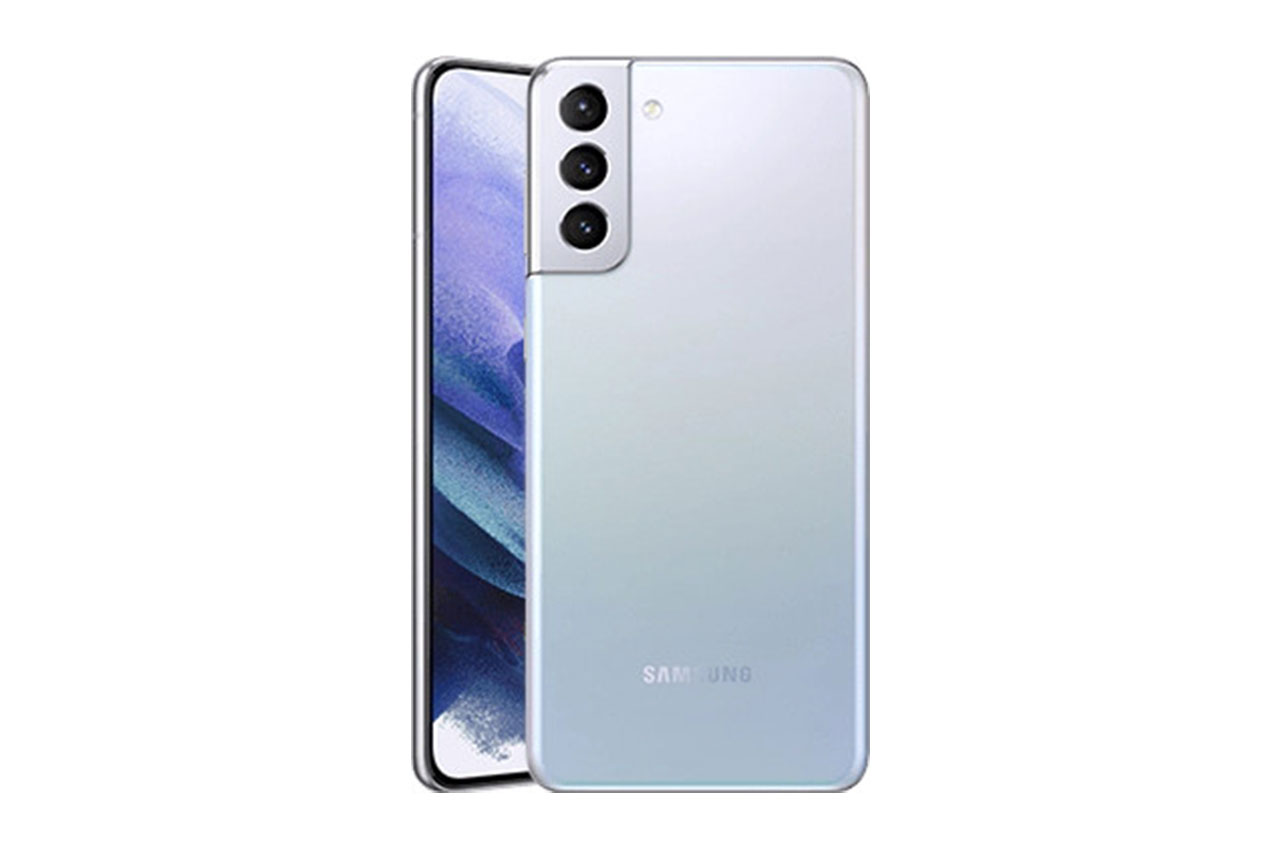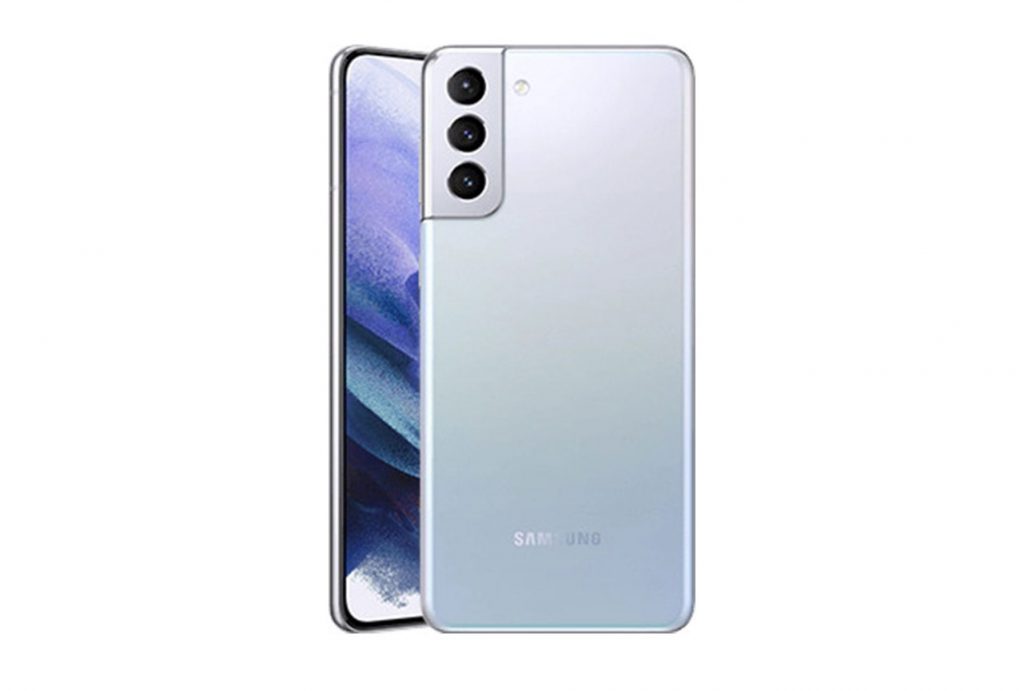Samsung’s Galaxy S21+ 5G is the middle seat of the company’s current high-end S21 series, squeezed between the slightly smaller S21 5G and the top-of-the-line S21 Ultra 5G. It sports a 120 Hz, 6.7-inch AMOLED screen, slightly larger than its sibling S21, but with the same resolution (2400 x 1080), and has a centered hole punch for the selfie camera. Here we are testing the US and China version, powered by Qualcomm’s Snapdragon 888 chipset, as opposed to the Exynos version available in the rest of the world. Both have 8 GB memory with either 128 GB or 256 GB storage.
There are three cameras on the back, with specs that exactly mirror the smaller S21. The primary camera has a 12 MP coupled with a 26 mm-equivalent optically stabilized lens. The ultra-wide offers 12 MP and has a 13 mm-equivalent lens. The tele camera used a wide-angle lens (29 mm-equivalent) but uses a 64 MP sensor, which gets binned down to 12 MP output.
The Galaxy S21+ 5G shoots video at up to 8K resolution at 24 fps; however, just like on the S21 Ultra and the standard S21 we used 4K and 60 fps for testing. Lower resolutions and higher frame rates are also available for recording in slow motion.
Key camera specifications:
- Primary: 12 MP 1/1.76-inch sensor with 1.8 μm pixels, 26 mm-equivalent f/1.8 lens, dual-pixel PDAF, OIS
- Ultra-wide: 12 MP sensor with 1.4μm pixels, 13 mm-equivalent f/2.2 lens
- Tele: 64 MP 1/1.72-inch sensor with 0.8μm pixels, 29 mm-equivalent f/2.0 lens
- LED flash
- 8K at 24 fps, 4K at 60 fps (tested), HDR10+
Achieving an overall score of 119, the Samsung Galaxy S21+ 5G (Snapdragon) captures almost identical image quality to the more diminutive S21 5G (Snapdragon); no surprise as the two models share the same camera hardware. We couldn’t get a cigarette paper between them in our analysis, so if you want to save a few bucks and can live with a smaller screen and lower capacity battery, the standard S21 5G (Snapdragon) is just as good for photography.
Samsung Galaxy S21 5G (Snapdragon), neutral white
balance and pleasant color rendering
Given the almost identical results, we are posting only this short article for the Galaxy S21+ 5G (Snapdragon). For a full set of sample images and measurements as well as a complete analysis, please click on the link below and read the full review of the Samsung Galaxy S21 5G (Snapdragon).
Go to the Samsung Galaxy S21 5G (Snapdragon) Camera review
Scoring
Sub-scores and attributes included in the calculations of the global score.
 Samsung Galaxy S21+ 5G (Snapdragon)
Samsung Galaxy S21+ 5G (Snapdragon)

115
camera
93
Huawei Pura 70 Ultra
Best: Huawei Pura 70 Ultra (130)
108
Apple iPhone 16 Pro
Best: Apple iPhone 16 Pro (130)
89
Huawei Pura 70 Ultra
Best: Huawei Pura 70 Ultra (125)
85
Xiaomi 15 Ultra
Best: Xiaomi 15 Ultra (125)
87
Huawei Pura 70 Ultra
Best: Huawei Pura 70 Ultra (117)
66
Xiaomi Redmi 12 5G
Best: Xiaomi Redmi 12 5G (82)
70
Huawei Pura 70 Ultra
Best: Huawei Pura 70 Ultra (85)
60
Apple iPhone 16 Pro
Best: Apple iPhone 16 Pro (93)
89
Xiaomi 15 Ultra
Best: Xiaomi 15 Ultra (128)
95
Huawei Pura 70 Ultra
Best: Huawei Pura 70 Ultra (122)
82
Oppo Find X8 Pro
Best: Oppo Find X8 Pro (116)
94
Oppo Find X8 Pro
Best: Oppo Find X8 Pro (120)
83
Huawei Pura 70 Ultra
Best: Huawei Pura 70 Ultra (120)
89
Oppo Find X6 Pro
Best: Oppo Find X6 Pro (118)
83
Apple iPhone 16 Pro
Best: Apple iPhone 16 Pro (120)
80
Xiaomi 12S Ultra
Best: Xiaomi 12S Ultra (86)
107
Apple iPhone 16 Pro
Best: Apple iPhone 16 Pro (119)
Use cases & Conditions
Use case scores indicate the product performance in specific situations. They are not included in the overall score calculations.
Outdoor
Photos & videos shot in bright light conditions (≥1000 lux)
Indoor
Photos & videos shot in good lighting conditions (≥100lux)
Lowlight
Photos & videos shot in low lighting conditions (<100 lux)
Friends & Family
Portrait and group photo & videos
Please be aware that beyond this point, we have not modified the initial test results. While data and products remain fully comparable, you might encounter mentions and references to the previous scores.
Position in Global Ranking

123
rd
4. Apple iPhone 16 Pro Max
157
10. Apple iPhone 15 Pro Max
154
22. Honor Magic4 Ultimate
147
26. Apple iPhone 14 Pro Max
146
26. Motorola Edge 50 Ultra
146
26. Samsung Galaxy S25 Ultra
146
32. Samsung Galaxy S24 Ultra
144
34. Apple iPhone 13 Pro Max
141
34. Google Pixel 9 Pro Fold
141
38. Samsung Galaxy S23 Ultra
140
43. Tecno Camon 40 Pro 5G
138
45. Vivo X80 Pro (Snapdragon)
137
52. Samsung Galaxy S22 Ultra (Snapdragon)
135
52. Vivo X80 Pro (MediaTek)
135
59. Samsung Galaxy Z Fold6
133
59. Samsung Galaxy S24+ (Exynos)
133
59. Samsung Galaxy S24 FE
133
59. Samsung Galaxy S24 (Exynos)
133
69. Samsung Galaxy Z Flip6
132
70. Apple iPhone 12 Pro Max
131
70. Samsung Galaxy S22 Ultra (Exynos)
131
81. Samsung Galaxy Z Fold5
128
83. Asus Smartphone for Snapdragon Insiders
127
83. Samsung Galaxy Z Flip5
127
83. Samsung Galaxy S23 FE
127
88. Vivo X70 Pro (MediaTek)
126
92. Asus Zenfone 11 Ultra
125
92. Samsung Galaxy S22+ (Exynos)
125
97. Samsung Galaxy Z Fold4
124
100. Apple iPhone 11 Pro Max
122
105. Xiaomi Redmi Note 13 Pro Plus 5G
121
106. Samsung Galaxy Z Fold3 5G
120
106. Samsung Galaxy S22 (Exynos)
120
106. Xiaomi Redmi Note 13 Pro 5G
120
111. Xiaomi Redmi Note 14 Pro+ 5G
118
114. Apple iPhone 12 mini
117
114. Samsung Galaxy S21 Ultra 5G (Snapdragon)
117
114. Samsung Galaxy S21 FE 5G (Snapdragon)
117
114. Samsung Galaxy S21 5G (Snapdragon)
117
120. Vivo X60 Pro 5G (Snapdragon)
116
123. Motorola Edge 50 Neo
115
123. Samsung Galaxy S21+ 5G (Snapdragon)
115
123. Samsung Galaxy S21 Ultra 5G (Exynos)
115
133. Crosscall Stellar-X5
113
133. Xiaomi Redmi Note 12 Pro+ 5G
113
137. Samsung Galaxy Z Flip4
112
139. Samsung Galaxy Z Flip3 5G
111
139. Samsung Galaxy S21+ 5G (Exynos)
111
139. Samsung Galaxy S21 5G (Exynos)
111
144. Samsung Galaxy A55 5G
108
144. Vivo X60 Pro 5G (Exynos)
108
149. Samsung Galaxy A54 5G
107
150. Xiaomi Redmi Note 14 Pro 5G
106
153. Samsung Galaxy A35 5G
104
154. Motorola Edge 40 Neo
103
154. Xiaomi Redmi Note 14 5G
103
156. Xiaomi Redmi Note 12 Pro 5G
102
158. Motorola Edge 30 Pro
101
160. Apple iPhone SE (2022)
100
162. Motorola Moto g75 5G
96
168. Samsung Galaxy A34 5G
92
168. Samsung Galaxy A25 5G
92
172. Xiaomi Redmi Note 13 5G
91
174. Motorola Moto g85 5G
88
174. Samsung Galaxy A52s 5G
88
174. Samsung Galaxy A52 5G
88
178. Motorola moto g54 5G
85
178. Samsung Galaxy A33 5G
85
178. Samsung Galaxy A16 LTE
85
181. Honor Magic6 Lite (5300 mAh)
84
181. Xiaomi Redmi Note 14
84
184. Samsung Galaxy A15 5G
83
186. Samsung Galaxy A15 LTE
81
187. Samsung Galaxy A53 5G
79
189. Xiaomi Redmi Note 11 Pro 5G
78
191. Samsung Galaxy A16 5G
77
193. Motorola Moto G35 5G
75
193. Xiaomi Redmi Note 13
75
196. Honor Magic5 Lite 5G
74
198. Samsung Galaxy A23 5G
70
199. Xiaomi Redmi Note 12 5G
69
202. Motorola moto g34 5G
67
202. Samsung Galaxy A14 5G
67
204. Motorola Moto G62 5G
66
205. Xiaomi Redmi Note 11S 5G
65
207. Xiaomi Redmi Note 12
63
212. Honor Magic4 Lite 5G
61
214. Xiaomi Redmi Note 11
60
216. Crosscall Stellar-M6
59
223. Xiaomi Redmi 10 2022
51
225. Samsung Galaxy A22 5G
48
Position in Ultra-Premium Ranking

83
rd
4. Apple iPhone 16 Pro Max
157
10. Apple iPhone 15 Pro Max
154
20. Honor Magic4 Ultimate
147
23. Apple iPhone 14 Pro Max
146
23. Motorola Edge 50 Ultra
146
23. Samsung Galaxy S25 Ultra
146
28. Samsung Galaxy S24 Ultra
144
30. Apple iPhone 13 Pro Max
141
30. Google Pixel 9 Pro Fold
141
34. Samsung Galaxy S23 Ultra
140
38. Vivo X80 Pro (Snapdragon)
137
43. Samsung Galaxy S22 Ultra (Snapdragon)
135
43. Vivo X80 Pro (MediaTek)
135
48. Samsung Galaxy Z Fold6
133
48. Samsung Galaxy S24+ (Exynos)
133
53. Samsung Galaxy Z Flip6
132
54. Apple iPhone 12 Pro Max
131
54. Samsung Galaxy S22 Ultra (Exynos)
131
61. Samsung Galaxy Z Fold5
128
63. Asus Smartphone for Snapdragon Insiders
127
63. Samsung Galaxy Z Flip5
127
68. Asus Zenfone 11 Ultra
125
68. Samsung Galaxy S22+ (Exynos)
125
71. Samsung Galaxy Z Fold4
124
73. Apple iPhone 11 Pro Max
122
76. Samsung Galaxy Z Fold3 5G
120
81. Samsung Galaxy S21 Ultra 5G (Snapdragon)
117
83. Samsung Galaxy S21+ 5G (Snapdragon)
115
83. Samsung Galaxy S21 Ultra 5G (Exynos)
115
89. Samsung Galaxy Z Flip4
112
90. Samsung Galaxy Z Flip3 5G
111
90. Samsung Galaxy S21+ 5G (Exynos)
111
Pros
- Neutral white balance and pleasant color rendering in most photos and videos
- Accurate target exposure in most photos
- High detail in outdoor and indoor photos and videos
- Pleasant bokeh photos with mainly accurate depth estimation
- Very wide field of view on ultra-wide shots
- Effective stabilization on walking videos
- Good white balance and color rendering on indoor and outdoor videos
- Accurate autofocus on most videos



 123rd
123rd 83rd
83rd




DXOMARK encourages its readers to share comments on the articles. To read or post comments, Disqus cookies are required. Change your Cookies Preferences and read more about our Comment Policy.